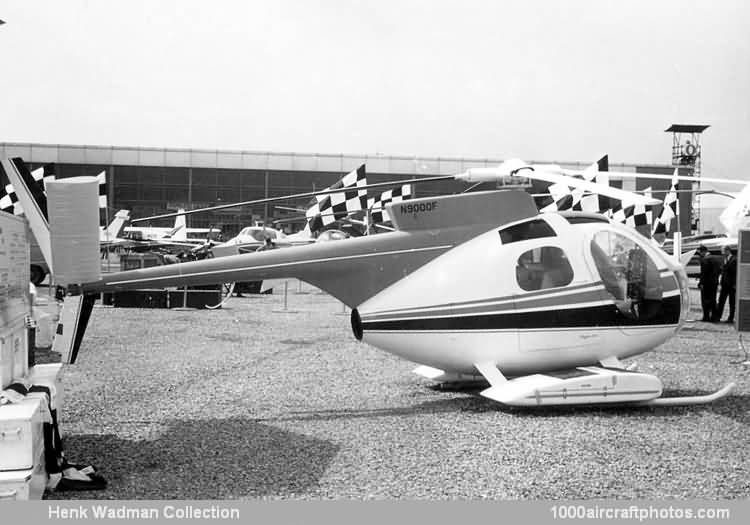12/31/2013. Remarks by Johan Visschedijk: "The light observation Helicopter (LOH) competition announced by the US Army in 1960 resulted in final proposals from Bell and Fairchild Hiller, with Hughes being included in the short list at the last moment.
The Hughes proposal was for a compact helicopter with what is best described as an egg-shaped fuselage with a tapered tail boom and four-blade semi-rigid rotor. Designed by Mal HarnÁd (who later conceived the Gates Twin-Jet Helicopter) the Model 369 (YOH-6A) was powered by an Allison 250 turboshaft, and five prototypes were built and evaluated at Fort Rucker in 1965.
The YOH-6A was smaller than its competitors but its performance, ease of maintenance and the ruggedness of its construction resulted in Hughes being awarded the production contract - much to the annoyance of Fairchild Hiller. Above all, it had a very competitive price and it was evident when the OH-6A went into production that Hughes would earn little or no profit on the contract.
The definitive 369A OH-6A embodied a number of changes over the prototypes, notably the replacement of the tapered monocoque tail boom with a slimmer unit mounting a three-finned tail. The US Army ordered 714 OH-6A 'Cayuses' (subsequently increased to 1420) which were delivered between 1966 and 1970. This was in time for the Cayuse to be deployed to Vietnam where it was used widely for armed support of the larger UH -1 transports, and for observation and artillery marking. The OH-6A was fitted with external weapons, most commonly including a 0.30 in (7.62 mm) XM-27E gun pod mounted under the left-hand cabin door.
While the Cayuse was progressing through its military evaluation, Hughes was also working on a civil counterpart, which was announced in the spring of 1965. This, and military export versions, had the engineering designation 369H and 369HM, and were marketed as Model 500 and 500M respectively.
Four 369 500 prototypes were built and registered N9000F, the first flew on September 13, 1966. In nearly overall-white it was first publicly presented at the Helicopter Association of America convention at Palm Springs, Colorado, January 15 to 18, 1967. Subsequently it was further modified and demonstrated by the company pilot Harold 'Hal' W. Hawkins at the 27th Paris Air Show May 26 to June 4, 1967. After receiving a new color scheme it was used as a demonstrator for the next two years. The civil model sold well, even though it had a somewhat smaller cabin than the competing Bell Jet Ranger. Its strengths were in having a higher maximum speed and greater range than the Bell aircraft.
The 369 500 was progressively improved with increasingly powerful variants of the Allison 250 turboshaft engine. The 369D 500D, introduced in 1976, had a modified T-tail, and the 369E 500E was distinguished by a reshaped fuselage pod with a slightly pointed nose. The 369 500 was also built under license in Italy by BredaNardi who delivered a substantial number to the Italian para-military Guardia di Finanza and a couple to the Maltese Armed Forces.
Military versions of all the later models were offered - particularly the 500MD Defender which was an unarmed scout or general purpose machine for export sale. Its offensive version, the Scout Defender, had armor plating and multiple external weapons hardpoints. Defenders have been delivered to a number of countries including the Philippines, Colombia and Mexico.
On January 6, 1984, Hughes Helicopters Inc. became a subsidiary of the McDonnell Douglas Corporation, and on August 27, 1985 the company name was changed to McDonnell Douglas Helicopter Company. The civil versions 369D 500D and 369E 500E were redesignated 369D MD 500D and 369E MD 500E respectively."
